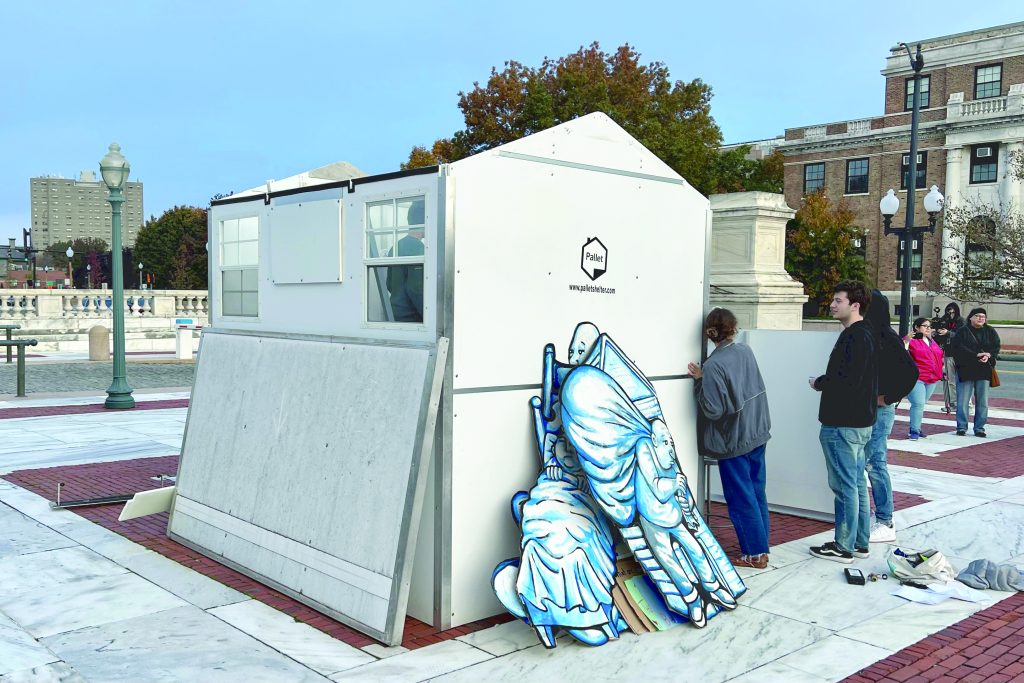
It appeared to be a straightforward solution initially. With a persistent homelessness crisis and a shortage of affordable housing, Rhode Island devised a plan to swiftly set up tiny pallet shelters as temporary relief for individuals living without housing in Providence.
The state purchased 45 of these basic 64-square-foot shelters from a company that constructs utilitarian living spaces using recycled plastic pallets. Theoretically, the pallet shelters could be quickly assembled into a tiny community with shared bathrooms and services — providing an expedient way to get unhoused people out of the bitter New England cold (or heat) and into basic shelter.
Ideally, these transitional micro-homes bought for around $8,000 each could offer a first step in getting lives stabilized, with access to support services while awaiting permanent affordable housing. With their straightforward construction, the pallet shelters eliminated much of the cost and red tape involved in building traditional homeless shelters.
But what started as an innovative, rapid solution quickly derailed into a bureaucratic quagmire of delays, red tape, and environmental headaches that have left the 45 pallet shelters sitting empty for months on Providence’s Victor Street with nary a resident in sight.
“We pushed very, very hard, so we were aiming for even sooner,” said Rhode Island Housing Secretary Stefan Pryor, acknowledging setbacks have plagued the project since the units first arrived last fall. “We’re an ambitious housing department, we’re a brand-new department so we can set a high bar for when things are going to get done.”
The saga began when soil testing at the planned pallet shelter site off Route 146 in Providence uncovered a startling discovery — the land was contaminated with toxic substances like lead and arsenic at levels exceeding safe residential limits.
The pollution was likely historic remnants from the site’s previous life. The shelter site is a grassy patch next to a railroad yard and highway ramps, and was transferred from the state’s transportation department to the new housing agency. While undisturbed, the contaminated urban fill posed no immediate risks. But plans for a compact pallet home village required urgent remediation efforts.
After approving an environmental remediation plan, crews excavated the worst contamination spots and installed a protective 2-foot cap over the remaining polluted soil to create a safe buffer. But those efforts, while eventually resolving the environmental concerns, led to months of delays.
As if the contamination hurdles weren’t enough, the pallet shelters then hit another roadblock with controversy over building code compliance. Since these tiny micro-shelters represent a new typology not explicitly covered under existing regulations, the state’s Building Code Standards Committee argued over granting necessary variances.
The key disagreements included whether the minimalist pallet shelters required costly sprinkler system installations, which are typically mandated for such multi-unit buildings, versus alternative fire suppression methods. There also needed to be more clarity among some committee members regarding the shelters’ design, despite the pallet shelter company providing the specifications. “These sleeping units and this very kind of specific and new programmatic occupancy are not addressed directly in the code,” a housing department representative admitted to the skeptical committee members.
After much debate, the committee finally approved key variances in mid-May to allow the pallet shelters to meet the code through alternative safety measures. With those regulatory hurdles cleared, state officials say they can finally set up the pallet shelter village over the summer months.
“We think we’ll be able to complete the set up this summer and that we’ll certainly open by the fall,” Pryor stated, effectively a year after the pallet shelters first arrived in hopes of quickly housing Rhode Island’s homeless population.
The saga demonstrates the challenges of quickly constructing alternative shelters due to environmental safeguards, evolving building codes, and bureaucratic processes not designed for such housing.
Whether the unique pallet shelters will live up to their promise of providing efficient temporary homes remains to be seen. But the torturous path to realizing this seemingly simple project demonstrates that for unhoused populations, finding expedient housing solutions is anything but straightforward.
The pallet shelters symbolize the challenges that Rhode Island’s unsheltered residents face in quickly turning innovative housing ideas into reality. There will certainly be delays before the first resident moves into the micro-dwellings, representing society’s latest experiment with emergency shelters.